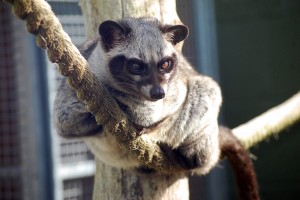
African Palm Civet, Nandinia binotata, is a solitary, nocturnal, arboreal mammal, also commonly known as the Two-Spotted Palm Civet. Unlike the other Civet species which are all very closely related to one another, the African Palm Civet is in a genetic group of it’s own, making it the most distinctive among the Civet species. Civets are called Età in Yoruba. It is a small animal with short legs, small ears, and a body resembling a cat. Despite their cat-like appearance and behaviors, the African palm civets are not felines at all but are in fact more closely related to other small carnivores including weasels and mongooses.
Like primates, civets use their ‘hands’ to grab prey or fruit before biting it. Civets feed on fruits, rodents, birds, eggs, carrion, bats and insects. It drops out of trees in play. It also descends tree trunks like a squirrel, head first. High proportions of Two- spotted Palm Civet carcasses among other bushmeats found in Rivers State markets have been attributed to their susceptible to hunting, since their dependence on fruiting palm trees makes their ranging behavior more predictable.





















